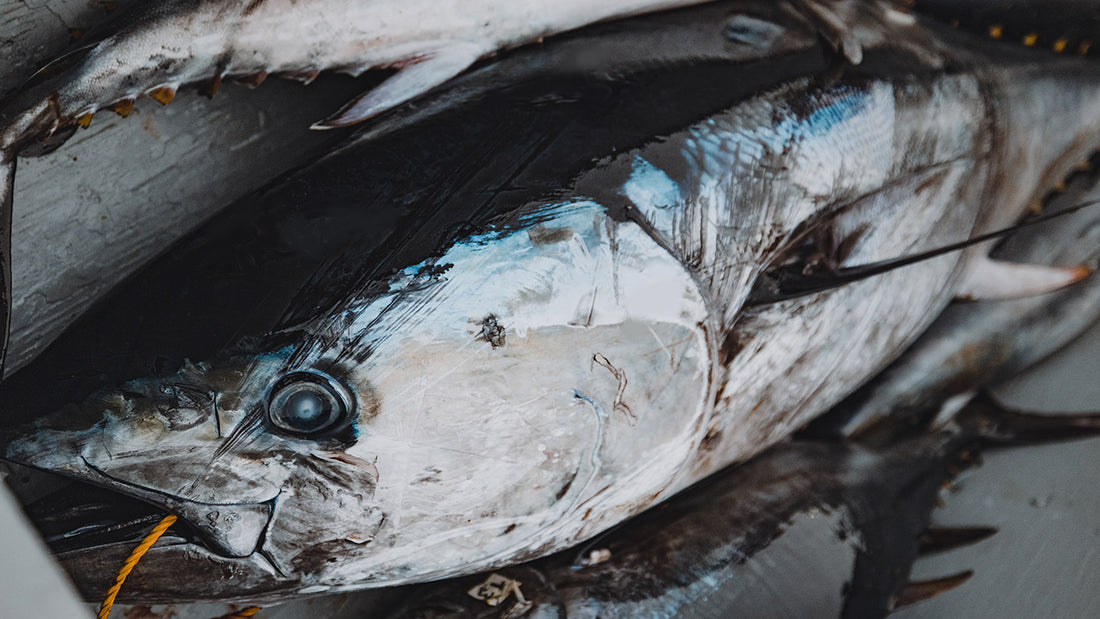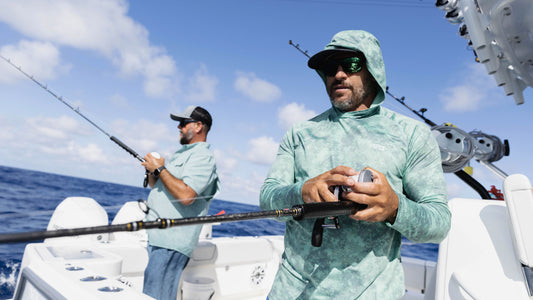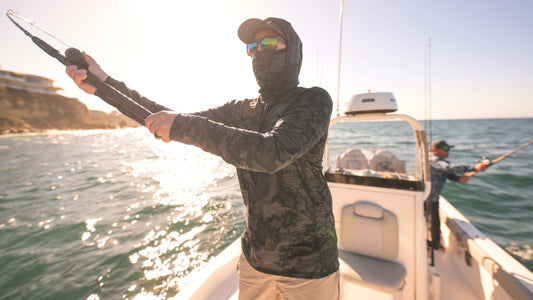
Species Spotlight: Bluefin Tuna
Bluefin
Thunnus thynnus
Thunnus orientalis

Illustration by Amadeo Bachar: StudioAbachar IG: Abachar
The Bluefin Tuna. Seen by many as a saltwater trophy species, there are three species of Bluefin tuna: the Pacific Bluefin, Atlantic Bluefin, and the Southern Bluefin. The Southern Bluefin is found exclusively in the southern hemisphere and is an endangered population, so we will focus on the Atlantic and Pacific.
The Atlantic and the Pacific Bluefin are accessible in many parts of the United States. Both reaching well over 100 pounds, they become a trophy hunter's dream later in their lives but are no slouch when they are “football” sized.
Considered the king of tunas, the bluefin tuna species are apex predators feeding on a plethora of smaller fish and invertebrates, which leads to success on many different lures when fishing. Whether you want to catch them on topwater, metal jigs down deep, or live bait, bluefin are ready to eat and you better be ready for the fight of your life.
Being the king of the tunas has its drawbacks as well. They are one tasty animal and populations fluctuate frequently because of the possibility of overfishing. The Atlantic Bluefin (Thunnus thynnus) takes the grunt of criticism regarding overfishing, but NOAA has the Atlantic Bluefin listed as “Not Threatened”. The Atlantic Bluefin has very strict regulations in the Northeastern United States, the Gulf of Mexico, and the Nova Scotia area in Canada. These regulations have helped the species rebound from the former classification of "Endangered" to a species "Of Least Concern".
The Pacific Bluefin Tuna (Thunnus orientalis) is listed as threatened. Their status supports the idea that fish stocks in our oceans can be tough to measure and forecast at times. As fisherman, responsible fishing and not taking more than needed is essential for important species such as the bluefin.

It is good to note that tuna can lose and change colors once they are on the deck of the boat. Here is a picture of what a tuna looks like on the deck. The way most will see them.

Appearance: The Bluefin tuna displays the most accurate definition of a fusiform fish. Fusiform - a fancy word for torpedo-shaped and you can see the tuna fits the bill. With such a hydrodynamic body, fish in the tuna family have an easier time swimming at high speeds through the water.
Along with the body shape, you will notice bluefin do not literally have a blue fin. Rather their top side is a very dark blue (almost black) contrasting the bottom silvery white. This countershading helps the fish camouflage in water and helps them be better predators. Additionally, their finlets, or the tiny fins on their tail fin, are bright yellow and the rest of the fins protrude creating stability at high speeds.
Their iridescent color is something many notice when the fish comes out of the water. This beautiful mirror glow can be seen not only on the bluefin but on the smaller tunas, even the mackerel (related to tunas).
Location/habitat: The three bluefin species occupy much of the worlds open oceans. They are pelagic sportfish travelling many miles in a lifetime, but you will see one species in each ocean.
As the name implies, the Pacific Bluefin can be found in the Pacific Ocean from Asian to North America, Atlantic Bluefin in the Atlantic from North America up around Canada and down to the Mediterranean, and the Southern Bluefin occupies the Indian Ocean and can circumnavigate the whole southern hemisphere.
As far as habitat goes, the pelagic bluefin will not have a specific structure or cover they prefer. Instead, much of bluefin's open water habitat is based on one thing, BAIT. They will follow bait around the world's oceans, but something noticeable, at least for the Pacific BFT, is that the fish push bait up where deep sea high spots are present. They push the bait up to the surface providing a barrier they can feed against. What it also provides is the perfect chance or us to target them. Atlantic Bluefin are different because of the composition of the Atlantic Ocean. Because the continental shelf stay shallower longer, these bluefin can be found and caught between 30 and 90 feet! It is not uncommon for 1000 pound bluefin to be present in very shallow water providing quite the spectacle for the fisherman in that area.

Size: Atlantic Bluefin: 13 feet and 1200 Pounds!
Pacific Bluefin: 10 Feet and 900 Pounds
Southern Bluefin: 8 Feet and 570 Pounds
What is the World Record Bluefin
The largest bluefin of all three species that is certified by the IGFA is an Atlantic Bluefin weighing 1496 pounds! The Atlantic Bluefin is the largest of all three species so it is obvious it would hold the record, but there have been sightings and landings of fish even larger than 1496 pounds. Since the Atlantic Bluefin has strict regulations as well as IGFA's requirements for submission, some fish are not certified.
Pros: Incredibly hard fighters, delicious table fare, found all around the world, can be caught on many different lures and live bait.
Cons: The conservation of the species is a complicated web, BFT can be very finnicky to catch at times providing heartache and headaches for the angler.

Tips for Targeting Bluefin Tuna
As many have found out, BFT can be about as finnicky as any fish out there. Compared to tuna cousins such as the yellowfin tuna, the BFT cannot be tricked on such “simple” offerings as the YFT. Nonetheless, many have mastered the art of the angling for these fish and here are some compiled tips for the legendary Bluefin Tuna.
PACIFIC REGION
Erik Landesfiend- "While bluefin tuna can be easy to find when they’re up foaming on a late morning or afternoon slack tide, they can be very difficult to locate when they’re not feeding on the surface. When scouting for bluefin before the tide, keep a close eye on birds, especially terns and shearwaters. Even a single highly focused tern can be a sign of subsurface bluefin feeding activity. When looking for terns, keep an eye out for those that are locked in on a particular section of water rather than those that are flying in a generally straight line. Terns picking on the surface can be a sign of tuna just below but high flying terns can be on tuna as well. A good rule of thumb to keep in mind is that the higher the terns are flying, the deeper the fish they are looking at. When those high flying terns dive towards the surface, there’s usually a tuna chasing bait up from below. Rafts of shearwaters sitting on the surface can indicate deep tuna as well. If you see a raft of birds when you’re cruising around, drive close enough to get them up and flying. If they scatter, they were likely just resting, but if they circle back and land where they were sitting before, there’s a good shot that they are sitting over a school of bluefin."
Ali Hussainy- "Preparation! Build a game plan and execute it. Focus efforts on having your crew and gear up to speed. All reels should be spooled up with quality braid and a wind on you can count on. Have plenty of helium, balloons, floss, bait rigs and baits ready to roll if you plan to fly the kite. Each crew member should have a job like rigging baits, deploying the kite, angler, wheel man and gaff man. With a plan in place before all hell breaks loose your crew will work calm and like a team when the pressure is on. This is what puts fish on the deck at the end of the day."
ATLANTIC REGION
Capt. Tom Cuilla- "My motto is that “Success is in the Details” when it comes to locating, hooking and landing bluefin tuna. Making sure all your gear is in solid working order is the first preparation. Fluorocarbon leader is best and Saiko Pro is my choice as it’s strong and flexible with a rugged exterior that will stand up to the rigors of a long and often violent fight.
Keep your boat and decks clean and organized. Make sure each crew member has a well defined role and knows they may be called to take over another’s role including the helm during the fight (which can last 20 minutes to 2hrs plus, plus) When setting up, be aware of your environment and on the look out for, whales, birds, surface feeds, oil spots, fishing pushing, etc. Prime time for tuna feeds is generally slack tide, but tuna will always keep you guessing and surprise you in any tide and any light, day or night.
Tuna fishing is the pinnacle of sport fishing and these majestic creatures are a true gift to all who pursue them. Be respectful of this precious resource and follow the rules and regulations associated with them. As with any fish, only harvest what’s necessary and use proper catch and release techniques for all non harvested fish so we can preserve this sport for ourselves and the generations behind us."
Jonathan Wolff - Jon's tips refer to preparation in knowing the boundary lines for regulations. Certain boundary lines will adjust the regulations and you need to know where these lines are and if you cross them to be aware of the changes, or to not cross them at all especially in the form of the Canadian border on the water because is it illegal for a United States citizen to cross the border to fish for bluefin recreationally.
Jon's second tip is to really consider a guide for your first trip if you are new to bluefin fishing. The guides, especially in the Northeast, are friendly with each other and talk every day about the fish and where they are. This makes them very efficient at putting clients of fish of their lifetimes. For someone going with no prior experience, it is much tougher to find and catch these fish.
As you can see, there are noticeable trends with our AFTCO pros, whether on the East Coast or the West Coast, that helps them be incredibly successful catching finnicky bluefin tuna. Preparation is critical with your gear as well as your crew. Slack tide is prime time to find fish easier, but they can eat at any time. And being aware of your surroundings, especially birds, can mean success any time of the day.
Bluefin Scientific Illustration created by Amadeo Bachar. Visit his site at StudioAbachar. IG: Abachar



